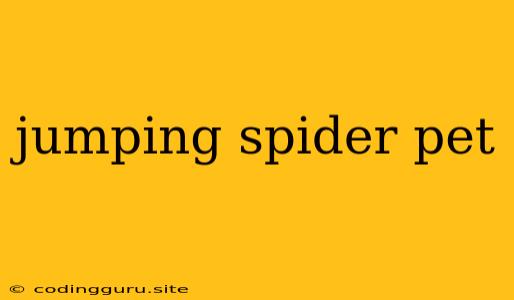Jumping Spiders as Pets: A Guide to Caring for These Fascinating Creatures
Jumping spiders, with their large, expressive eyes and remarkable agility, are quickly becoming a popular choice among pet enthusiasts. Their unique personalities and captivating hunting techniques make them a truly mesmerizing addition to any household. If you're considering welcoming a jumping spider into your home, it's crucial to understand their needs and how to provide the best possible care. This comprehensive guide will delve into the fascinating world of jumping spiders, answering key questions about their care, housing, feeding, and much more.
Why Choose a Jumping Spider?
Jumping spiders are fascinating creatures that offer a unique and rewarding pet ownership experience. Here are some reasons why they make great companions:
- Intelligence and Personality: Jumping spiders exhibit remarkable intelligence, exhibiting curiosity and even recognizing their owners. They are active and playful, making them engaging to observe.
- Low Maintenance: Unlike many other pet spiders, jumping spiders are relatively low-maintenance. Their enclosures are small, and they don't require extensive cleaning.
- Fascinating Behavior: Watching a jumping spider hunt is truly captivating. Their precise leaps and incredible eyesight are a testament to their natural hunting abilities.
- Variety and Beauty: There are numerous jumping spider species, each with its own unique colors, patterns, and personalities.
Setting Up the Perfect Jumping Spider Enclosure
A properly set-up enclosure is crucial for the well-being of your jumping spider. Here's what you need to know:
- Size: A 1-gallon terrarium is generally sufficient for most jumping spider species. The enclosure should be tall enough to accommodate your spider's jumping ability.
- Substrate: A layer of peat moss or coconut coir provides a suitable substrate for your jumping spider. This helps to regulate humidity and provides a natural environment.
- Decor: Include various hiding places, such as cork bark, bamboo tubes, or small plastic plants. These provide your spider with a sense of security and encourage natural behaviors.
- Water: Provide a small water dish or mist the enclosure daily to maintain appropriate humidity levels.
Feeding Your Jumping Spider
Jumping spiders are carnivores, and their diet consists primarily of live insects. Here's what to keep in mind when feeding your jumping spider:
- Food Sources: Offer a variety of insects such as fruit flies, crickets, and mealworms. The size of the prey should be no larger than the spider's abdomen.
- Frequency: Young jumping spiders may need to be fed daily, while adults can be fed every other day or less often.
- Variety: A diverse diet helps ensure your jumping spider receives all the necessary nutrients.
- Supplementation: Occasionally, you can offer a calcium supplement to promote healthy growth.
Handling Jumping Spiders: A Gentle Approach
While jumping spiders are relatively docile, it's important to handle them with care.
- Acclimatization: Allow your jumping spider to settle in and acclimate to its new environment before attempting to handle it.
- Gentle Touch: When handling your jumping spider, use a gentle touch and avoid squeezing or dropping it.
- Safety First: Always handle your spider over a soft surface, like a bed or carpet, to minimize the risk of injury.
- Observation: Observe your spider's behavior to understand its temperament. Some spiders are more tolerant of handling than others.
Identifying and Addressing Jumping Spider Health Issues
Like any pet, jumping spiders can experience health issues. Recognizing potential problems early on is key to ensuring their well-being.
- Molting: Jumping spiders shed their exoskeletons as they grow. Ensure a humid environment during this process, as it can be stressful for the spider.
- Dehydration: Monitor the humidity levels in the enclosure and offer fresh water to prevent dehydration.
- Parasites: Signs of parasites can include lethargy, weight loss, and unusual behavior.
- Predators: Keep your jumping spider's enclosure securely sealed to prevent predators from entering.
Conclusion
Jumping spiders, with their remarkable intelligence, agility, and captivating personalities, make captivating and rewarding pets. By providing them with a suitable enclosure, a varied diet, and attentive care, you can ensure a long and healthy life for your jumping spider companion. Remember to do your research, learn about your specific species, and provide them with the best possible care to enjoy their unique and fascinating world.
